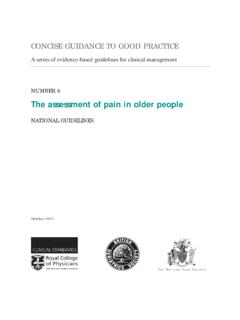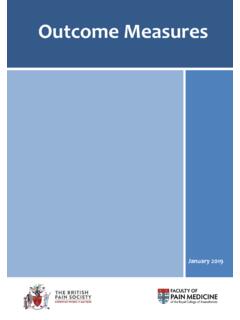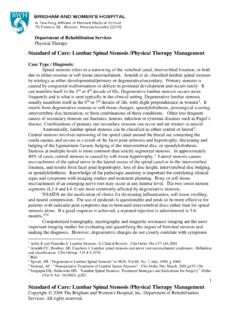Transcription of Understanding and managing pain: information for patients
1 The British pain Society Understanding and managing pain : information for patients January 2010. To be reviewed January 2013. 2 Understanding and managing pain Published by: The British pain Society 3rd floor Churchill House 35 Red Lion Square London WC1R 4SG. Website: ISBN: 978-0-9551549-9-0. The British pain Society 2010. information for patients 3. Contents Page 1 Who should read this booklet? 4. 2 Why doesn't my pain go away? 5. 3 What might this mean for me? 10. 4 What help is available? 13. Who can help me and what might they do? 13. What treatments might be offered? 16. Exercise 17. Manual therapy 20. TENS 20. Acupuncture 21. Drugs 21. Injections 27. Long-term devices 28. 5 What can I do to help myself? 29. 6 What is a pain -management programme? 36. 7 Summary 38. 8 More information 39. 4 Understanding and managing pain 1 Who should read this booklet? We all know what pain is. We have all suffered from it.
2 Sometimes, we hardly notice it. Sometimes, it's unbearable. Usually, it goes away on its own. Sometimes, it goes away with treatment. Rarely, it doesn't go away at all, but becomes persistent (sometimes called chronic) pain . There are many different causes for persistent pain . The aim of this booklet is to help you understand the difficulties associated with persistent pain , and how it can best be treated. In this booklet, we do not specifically cover pain caused by cancer, but much of what we describe here can apply to cancer pain . Whether your pain is recent or long term, severe or less severe, this booklet explores the best ways of managing it. We look at what pain is, what can be done about it, who can help you with it and how you can help yourself. The aim of this booklet is to help you understand the difficulties associated with persistent pain , and how it can best be treated. There are things that you can do to reduce the effects of pain on your life, such as appropriate exercise, pacing your activity (not doing too much when you feel better) and relaxation.
3 These things may not be obvious and they do not come easily. They take practice to get the most out of them. However, they can be as effective as taking medication (See page 29 for more information .). information for patients 5. 2 Why doesn't my pain go away? Some pain is easy to understand because, for example, there is an obvious injury such as a cut or a bruise. Some is less obvious. You cannot see the pain of appendicitis, but anyone who has had it will tell you that it is real enough. Health professionals use different terms for different types of pain . Short- term pain , such as a sprained ankle, is called acute' pain . Long-term pain , such as back pain , is called persistent' or chronic' pain . pain that comes and goes, like a headache, is called recurrent' pain . It is not unusual to have more than one sort of pain , or to have pain in several places. Many acute pains are a useful alarm signal that something is wrong.
4 Most minor ones get better on their own or with simple treatment. Others may be a sign of something more serious, such as a broken leg. This pain is helpful because it means that you get treatment and rest your leg until the break has had a chance to heal. On the other hand, persistent pain appears to serve no useful purpose, but has a huge effect on the lives of many people. 6 Understanding and managing pain I have had to give up work, which obviously not only cuts down the social contact I have with others, but leads to feelings of failure that I am no longer able to provide a wage to the household. My husband and children now do most of the housework and gardening, which were always my jobs, and although only in my thirties I now rely on their help for mobility and dressing. As you can imagine, my self-esteem is very low and the pain limits where I can go and what I can do.. pain can come from any part of your body : skin, muscle, ligaments, joints, bones (nociceptive pain ), injured tissue (inflammatory pain ), nerves (neuropathic pain ), internal organs (visceral pain ) or a combination of these types of pain (mixed pain ).
5 pain signals normally travel from the painful part of the body along thousands of specialised nerve fibres, through the spinal cord, to the brain. However, in some cases (for example, pain after a stroke), damage to the brain or to the spinal cord itself can start the pain sensation. You and medical professionals need to work together with skill, time and patience to improve the problem.. pain signals are initially processed in the spinal cord and then in the brain, where there are connections with centres associated with anxiety, emotions, sleep, appetite and memory. This creates a very personal experience of pain for each person. information for patients 7. How pain messages travel The brain sends signals back to the spinal cord, which can, in turn, either reduce or increase the pain further. Cells at the nerve endings, in the spinal cord and in the brain can become over-sensitised as a result of constant pain input.
6 This is called wind-up' and is one of the reasons why persistent pain does not go away easily, even if the cause of the pain is discovered and treated. 8 Understanding and managing pain In simple terms, the body's warning system becomes more sensitive, producing an increased feeling of pain even though there may no longer be any continuing damage to the body. This can lead to a long-term, distressing problem. You and the medical professionals need to work together with skill, time and patience to improve the problem. Although medical technology is improving all the time, some pain is very complicated. It may involve so many factors that we will never be able to find the precise cause of it accurately with machines, or make it show up in any tests. However, not knowing the cause of the pain does not mean it is not a very real problem. Only the person in pain can really say how painful something is.
7 Because pain is always personal, no two people experience it in the same way. This makes it very difficult to define and to treat. pain is defined by the International Association for the Study of pain (IASP) as, an unpleasant sensory and emotional experience associated with actual or potential tissue damage, or described in terms of such damage ( ). The definition is important because it links emotion to the sensory experience. This means that the only way of deciding whether someone has pain is by asking them, or watching them. information for patients 9. Unfortunately, there is more to persistent pain than simply hurting. This is unpleasant enough by itself, but when it continues for a long time, it can affect every part of your life in how you cope with it. It may affect your ability to work, your relationships with family and friends, your activity levels and your sleep. All of this may become overwhelming and can cause a vicious circle of increasing pain and distress.
8 pain is never just in the mind' or just in the body'. It is a complicated mixture of signals from the body and how the brain interprets them. You know your pain , even though it cannot be seen or measured. The challenge for both you and those treating you is to understand the complicated nature of persistent pain and the best way of managing it. 10 Understanding and managing pain 3 What might this mean for me? Persistent pain is complicated and is not easily fixed'. You need to work alongside health professionals involved in the case and be patient and willing to try things to work out what is best for you. Unfortunately, you may still suffer from some level of pain because there may not be a complete cure. However, this does not necessarily mean that it will get worse, nor does it mean that continuing damage is being done. Understanding the pain , as far as possible, is important. You should ask the health-care professionals who are helping you to explain as far as they understand the things that worry you.
9 information for patients 11. Common worries are shown below. What is causing my pain ? Is it something which is likely to get worse? What are the investigations (X-rays, scans and so on) looking for, and what do my results mean? If my painkillers do not work, can I have stronger ones or what else can be done? If a painkiller works, will I still be able to feel any pain that might be telling me that something else is wrong and needs attention? Why can pain not be switched off? Could a surgeon not see something if he or she looked inside me, even if it doesn't show on a scan? If I take morphine or other similar drugs for my pain , will I get addicted? What are the side effects of the drugs I am taking? What is the effect on my body of taking drugs for a long period of time? 12 Understanding and managing pain It will help those looking after you if you can give them the answers to the following questions.
10 What makes the pain worse? Is this straight away or after a while? What eases the pain , even a little? What does the pain stop you doing? What can you still do, but avoid doing because it hurts too much? What do you not do because you are worried you might damage yourself? Does the pain prevent you from getting off to sleep? Does the pain wake you from your sleep? Does your mood or stress affect your pain ? If you are taking a painkiller, how well does it reduce the pain and for how long? To find the best treatments for you, it is often necessary to try various options and see if they help. This is not because the health-care professionals do not know what they are doing, but because pain is complicated and every pain and every person is different. information for patients 13. 4 What help is available? Who can help me and what might they do? There is a great deal that can be done to help you. The best results come when you understand that you need to play an active role in treating your condition, alongside those who are treating you.









